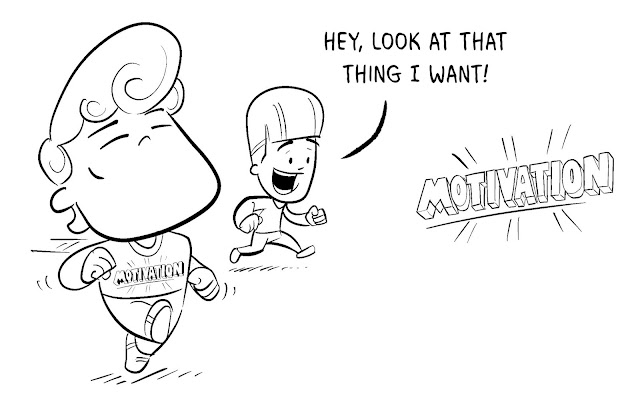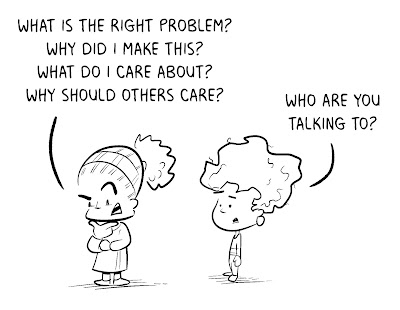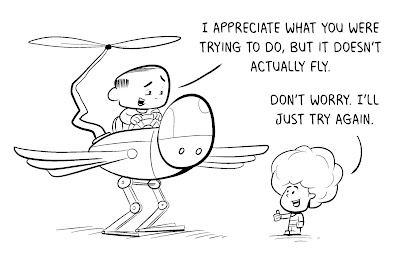A lot of school subjects teach students to seek out “The Right Answer.”
But when we engage in a creative project, “The Right Answer” doesn’t exist yet. It’s our job to create it.
So what if all that time we spend creating, leads to something that is essentially useless? What if we don’t find an answer to anything? Was that time wasted?
Creativity is scary
There is a certain safety in knowing that ‘The Right Answer’ already exists somewhere in the world. Even if we don’t know what it is yet, it’s reassuring to believe that our choices will definitely lead somewhere.
Not only that, but for the majority of subjects at school, there are books for us to reference and teachers to help guide us.
This path, that has already been laid out for us, with rewards that appear guaranteed, seems much more secure. So secure in fact, that it can quickly render what we think, want or believe as irrelevant.
When we take the less secure path and set out to create something new, we travel a road that no one else has travelled before. It is unique to us and no one will be there to guide us.

The truth of taking this direction is that we could put hours and hours of time and effort into a project, only to find out that no one cares.
All that time spent finding out what makes us unique, forming our own opinions and making decisions based on how we feel will seem wasted.
Sure, we might have made something new, but is it useful?
At this point, anyone would be forgiven for taking a path which appears to offer plenty of certain answers and abundant rewards in comparison.
This process is made even scarier when we have taught people to define their worth by their outputs. When it is not the process that we underwent, but the grade that we received at the end that anyone cares about.
This leads us to begin to form a belief that we don’t have the right answer, others do and we stop taking risks, making choices for ourselves or believing in our own innate, unique value unless it is immediately recognised by others.
The problem is, that even though it is scary, being creative is important, not just for our own well-being, but for our society. We must learn to trust our own choices and to take risks. However, a journey such as this, with a much feinter glimmer of hope at the end, requires courage.
Where does courage come from?
Courage is born as soon as someone makes that choice to do the scary thing.
That choice though, needs to find its motivation from somewhere. If it’s not from seeking a reward, where does it come from?
Here are a few things that will help a person to make the brave choice to exercise their creativity, without the promise of a reward at the end.
ENJOYMENT
Enjoyment of a task can be a huge component of motivation. If we think of motivation as energy, when we enjoy a task, we generate more energy from it than we put in.
An interesting component of enjoyment is that we actually enjoy an activity less when we are rewarded for it. The feeling of recognition is incredibly satisfying, but if we feel as though we are doing something solely for the reward, the enjoyment of the task is sullied.
This is because the motivation for doing the task is moved from within us to outside of us.
As a result, we feel like we are doing the task because someone else has asked us to and therefore, we enjoy it less.
When we choose to do something, simply by virtue of it being our choice to do it, we enjoy it more.
If we are doing something creative, it is up to us to make all the choices. We choose the path, we choose how we spend our time, what we focus on and why, all to serve our own internal motivations.
This process is incredibly satisfying and will encourage people to do it again, even if they don’t produce anything of value at the end of it.
PURPOSE
A strong sense of purpose is another effective motivator in the face of fear.
When we reach the end of a creative endeavour, we’re faced with a difficult question.
“Who cares?”
With this, we are offered an opportunity to question the choices we made and better understand the purpose of our creation.
The purpose of our creation may be simply that we enjoyed the process of creating it and so we don’t care what others think. We'll do it again anyway.
Or we may decide that we want others to care about what we create.
And so begins the search not for, “The Right Answer,” but for, “The Right Problem.”
This is a process of asking questions.
Either way, it is in better defining the purpose of an activity that we’ll find the strength required to defend its role in our lives.
BELIEF
Beliefs are the stories we tell ourselves, about ourselves and the world around us.
Through the scary process of creativity, we will experience many failures. We will set out to create things that we think others care about and they won’t, because it doesn’t work, or we didn’t communicate ourselves well enough.
When faced with this failure, we write ourselves a story of what will happen next.
We will either tell ourselves that we have failed, we are failures and that we should stop trying…
Or we will tell ourselves that this is merely a hiccup and one day we will achieve what we set out to accomplish.
I believe that it is not the end goal, but the process that is most valuable to us. However, in the face of terrifying circumstances, a belief that we will succeed in our goal will help to encourage us to keep going. Those that do not believe they will succeed, will not.
How can we help?
We can help by giving students the space they need to be creative.
We can enhance their enjoyment by not interfering.
Ask questions and encourage, but allow the solution to be their discovery. When we interfere and offer suggestions, it can seem as though we have the answers and that they do not. When this happens, students stop making free choices, deferring to the opinion of others, and this reduces the pleasure of the activity.
We can help them to find their purpose through honest communication.
When it comes to purpose, we draw the greatest sense of validation and worth from helping others. So show kids how satisfying a thank you can be rather than a well done. Teach them about compassion and empathy by initiating discussions and communicating with them honestly and openly.
We can help them believe in themselves by showing that we believe in them.
The greatest signifier of what we believe is how we choose to use our time. By simply giving students the opportunity to be creative at all ages, we tell them that we believe this process is worthwhile and that we trust in their capacity to make constructive choices.
Ultimately, we should remember that it is the process of creativity that has the greatest value, not the output.
It is the process that teaches kids that they can be happy, by finding what they enjoy and making the time for it. It is the process that will help them to find a purpose and establish a sense of identity. It is the process that will teach them to establish positive beliefs that give them the courage to make their own choices.
What we don’t want is people going through their lives without knowing what problem it was they were trying to solve in the first place.



























